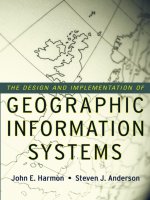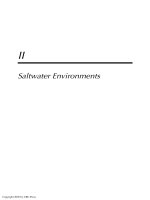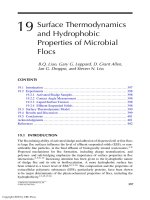Community Participation and Geographic Information Systems - Chapter 23 ppt
Bạn đang xem bản rút gọn của tài liệu. Xem và tải ngay bản đầy đủ của tài liệu tại đây (313.31 KB, 11 trang )
Spatial multimedia
representations to support
community participation
Michael J. Shiffer
Chapter 23
23.1 INTRODUCTION
One of the criticisms levelled against GIS and similar spatial informa-
tion systems (as they relate to public participation), is their relative ina-
ccessibility and the lack of capacity to incorporate informal mental
models, such as personal anecdotes and observations. This chapter
explores some potential roles that complementary technologies to GIS
can play in facilitating public participation in planning contexts. The
complementary technologies, which afford the capacity to link images,
text and sound to maps will be referred to in a general sense as spatial
multimedia.
Three perceived impediments to participation comprise: (1) the inability
to physically attend meetings; (2) being unable to understand others; and
(3) struggling to have competing views understood by others. For each of
these, various implementations of spatial multimedia are described that begin
to overcome each impediment, thus achieving an enhanced degree of public
participation in a specific context. Finally, several areas where additional
research is needed will be identified.
23.2 IMPEDIMENTS TO PUBLIC PARTICIPATION
There are many political, organizational and institutional impediments to
public participation in planning contexts. These have been explored exten-
sively throughout the planning literature (cf. Forester 1989; Innes 1996; Day
1997; Tett and Wolfe 1991). This chapter focuses on the tangible impedi-
ments to public participation, and how IT can address those. This chapter
does not suggest that IT can be an easy cure to participation challenges.
Rather, it is proposed as a potential catalyst towards a more inclusive
process.
© 2002 Taylor & Francis
23.3 IMPEDIMENT: JUST GETTING THERE . . .
The results of GIS analyses are often conveyed to the public in the context of
meetings. Yet one of the more significant impediments to public partici-
pation in planning is simply being physically able to attend meetings. This
can be particularly challenging for the elderly and physically challenged,
especially in climates with diverse weather patterns. Furthermore, being at
meetings can be a significant challenge to ‘two-income’ families or families
with small children, where a willingness to attend such a meeting can often
be superseded by simple practicality. Finally, there may be a degree of
ambiguity surrounding how relevant the agenda of a particular meeting
may be to a specific individual. All of this tends to lead to lessened public
participation on routine matters, and perhaps even an unintentional lack of
participation on matters of particular relevance.
23.3.1 How IT can help: virtual presence
In recent years, IT in the United States has matured to a point where it can
be employed to bridge the physical gap between planning meetings and
those who wish to attend them. A category of technologies can support a
degree of virtual presence at a meeting – thereby complementing the data
handling and mapping capability of GIS. The most relevant technologies
include cable TV access, video teleconferencing, and WWW access. GIS can
play an active role in all of these forms of virtual presence due to the cap-
acity of the technologies to effectively transmit live displays from GIS
applications. Hence, the user can often have the option of transmitting a
realtime image of a human, a place, or a map.
23.3.1.1 Public access cable television channels
Cable TV has been popular in the United States since the 1970s. A key elem-
ent involved in the granting of many local cable franchises is the required
provision of a public affairs channel which enables broadcast of city or town
council meeting and planning. Often these meetings involve a one-way inter-
action between the meeting and the viewer. This level of participation is rela-
tively easy to attain, for many US households have cable TV access, and it’s
easy to use, as it simply involves switching on a TV and watching. Although
most immediate interaction is one-way (from the meeting participants to the
viewer), and traditional feedback mechanisms (such as letter writing and
telephone calls) may be employed, some of the more forward-thinking munic-
ipalities may actually provide a mechanism for immediate viewer feedback
by taking phone calls during the meeting. These situations, however, are rare.
A less-formalized mechanism for public participation that also involves
cable television access and viewer participation, can be found within the
310 M. J. Shiffer
© 2002 Taylor & Francis
public access model of local cable TV franchises in the United States. For
example, several years ago, Cambridge (Massachusetts) Community
Television developed an ‘electronic soapbox’ known as ‘BeLive’. BeLive con-
sists of a desk with a phone and two chairs. Any citizen wishing to broadcast
on the local cable television channel simply sits at the desk, flicks a switch to
turn on the camera, and instantly he or she is broadcasting to the local com-
munity. The citizen may announce the number of the phone at the desk and
broadcast conversations with viewers. Although BeLive is a relatively ‘low-
tech’ approach to public involvement, it demonstrates how an innovative use
can be made of existing technologies.
Both the BeLive and the traditional model of cable TV access have the
capacity to convey limited spatial information. This information can be made
available through simple mapping tools or software that provides rapid
access to a set of maps (such as Adobe Acrobat or Microsoft Powerpoint).
Nevertheless, when using this mode of transmission, special attention must be
paid to the fact that TV is an exceptionally low-resolution medium. This is
further complicated by the fact that the NTSC video broadcast standard in
North America scans every other line of a video signal in an alternating man-
ner that leads to a ‘flicker’ of thin horizontal lines. Finally, the use of bright
colours can be problematic for broadcast signals. All of this adds up to the
fact that it can be useful to learn the following simple tactics from television
news organizations about the broadcast of maps: (1) display maps at a scale
suitable for simple and clear reading; (2) use muted colours whenever possi-
ble (i.e. maroon rather than red, mustard rather than yellow); (3) Draw lines
thickly to avoid flicker; (4) remember that people viewing these maps
will have very limited time to see them, so keep them simple. For example, if
necessary use a slow succession of simple maps rather than a single map to
convey multiple attributes.
23.3.1.2 Video conferencing
Another relevant form of IT with the capacity to enable ‘virtual presence’
is video conferencing. This technology has matured and is extensively used
by private industry, where collaboration most often takes place over great
distances. Video conferencing has only rarely been used to facilitate public
involvement in local affairs, however, due to its relatively high cost (for
both infrastructure and connection). It is more typically used by the private
sector where elimination of travel over great distances is economically
feasible. Access to the technology in the United States has changed sig-
nificantly in recent years, due to the fact that many service bureaus (such as
Kinko’s Copy Shop) have installed video conferencing stations and charge
a small fee for access to these facilities. However, use of this technology is
dominated by the private sector, where activities such as remote interviews
of job candidates might make economic sense.
Spatial multimedia representations 311
© 2002 Taylor & Francis
However, video conferencing can be relevant to public participation in
local government where it may be necessary to draw upon remote expert-
ise to solve a local problem. In this context, cities have the capacity to meet
remotely with consultants for progress reports on projects ranging from
real estate development to transit improvements. When using video confer-
encing to convey spatial information, one needs to be cognizant of the same
technical limitations as described above for cable TV access (regarding
thickness of lines, use of colour, etc.). One exception to this is that since
video conferencing is a two-way conversation, maps can be redisplayed for
longer duration at the request of the other party, and it may be possible to
use more complex maps in these situations. Cable TV and video conferen-
cing may indeed bridge the gap of space; however, participation using these
technologies still requires that all participants be involved at the same time.
23.3.1.3 ‘Getting There’ through the Internet
The development of the Internet and the WWW is really a centerpiece
addressing the physical inaccessibility of spatial information systems. Data
and information are no longer tied to a discrete set of machines in a single
location such as a planning office. Instead, Internet-based GIS makes it pos-
sible to access this data from virtually any suitable machine in the world
provided that it has an effective network connection. ‘Suitable machines’
can range from desktop units to hand-held devices used in the field. By
virtue of the WWW’s global system of associative document links, as well
as the Internet’s capacity to support remote conferencing (or less formal
‘threaded’ conversations via discussion groups and mailing lists), this tech-
nology has profound implications for enhancing public participation by
bridging the barriers of space and time. The Internet enables interactive
conversations among multiple stakeholders. Furthermore, the WWW
affords multiple channels of access to a variety of media in the form of
linked maps, images, and documents. In this context, however, the concern
is the capacity of the Internet to facilitate virtual presence.
Access to the Internet has been growing rapidly in the last few years. This
is attributable to the many thousands of households that gain access to the
Internet each day through their personal computer and either a telephone
line or a cable TV connection. Furthermore, wireless access to the Internet,
though still in its infancy, is rapidly growing. However, for those concerned
about equitable access to public participation in local affairs, the Internet
can be viewed as a barrier between those who are affluent enough to afford
access from the home computers and those who can’t. Fortunately, there has
been movement in both the private and public sectors to address this issue.
On the private side, several Internet providers have initiated programmes
where they will give away personal computers to people who subscribe.
This, however, is probably small consolation to those who are concerned
312 M. J. Shiffer
© 2002 Taylor & Francis
with equity issues, since this model still requires a sustained outlay of cash
to support Internet access. Some programmes require no cash and are
instead fully supported through funds from online advertisements; however,
these can be difficult to become involved with, due to high demand for these
services. Another private sector model is ‘pay-as-you-go’ Internet access.
This was initially popularized by so-called ‘cyber-cafés’, but has recently
found its way to such routine places as the local McDonald’s. Here one finds
a kiosk-like machine that accepts cash (in this case, $1 for 20 minutes) for
Internet browser time. Nevertheless, the use of a McDonald’s Internet kiosk
to access local-government-related information has yet to be observed!
In the public sector, access to the Internet, and by implication to local
government information, has been made available through libraries and
other public buildings where clusters of computer terminals can often be
found. These are supplemented by a significant number of community com-
puter centres that have arisen in various low-income neighbourhoods.
Finally, physical inaccessibility to spatial information systems can be
addressed in a very ‘low-tech’ way by simply bringing a laptop computer,
projector and an information specialist to a planning meeting.
23.4 IMPEDIMENT: UNDERSTANDING OTHERS
For many years, planning professionals have been challenged to describe
technical information to non-technical audiences. Where abstractions have
been used to convey concepts such as noise and traffic levels, more descrip-
tive indicators have been somewhat elusive. Furthermore, it is often chal-
lenging for meeting participants to effectively describe a former, current or
proposed physical environment to those who may be unfamiliar with the
area or the time frame in question. Representational aids provide an imple-
mentation of IT that can support the gap of understanding that often exists
between the speaker and the audience.
Representational aids are designed to make the abstract more concrete
by employing a richer set of descriptions. They have evolved from gestural
and verbal tactics such as waving of hands and copious use of adjectives,
to artistic conceptualizations and the employment of linked media. The
intent has been to close ‘the gap of understanding’ between technical spe-
cialists and key stakeholders. This has most recently been accomplished
through the augmentation of typically abstract environmental representa-
tions with direct manipulation interfaces and multimedia representational
aids, which have been made available in planning settings through
increases in computing power over the last decade (cf. Câmara et al. 1991;
Shiffer 1995 and many other works on this subject).
For instance, as one observes public participation contexts, a gap often
becomes evident between what is being conveyed by a specialist at the head
Spatial multimedia representations 313
© 2002 Taylor & Francis
of a room and what the public understands. This gap can lead to mis-
understandings, arguments and ultimately mistrust. A noise specialist may
display a map of noise contours and describe to the public how each con-
tour line represents a noise level. Furthermore, the specialist may describe
this noise level as an aggregation of peak noise events, perhaps even going so
far as to provide a quantitative representation of Ldn (frequently character-
ized as noise level averaged over time with night time events weighted more
than day). Although talented and well-meaning professionals have the
capacity to effectively convey these concepts to an attentive public, often
times this may not be the case. Thus, it is important to employ some sort of
representational aid to bridge the gap between what the specialist intends to
convey and what the public can effectively understand. Such an aid might be
as simple as a spreadsheet calculation that conveys concepts such as annoy-
ance (Schultz 1978) or relative impacts on property values (Frankel 1981).
More complex representational aids might actually augment traditional
noise contour representations with digitally sampled recordings of actual
discrete noise events (Shiffer 1995). The combination of such representa-
tional aids is illustrated in Figure 23.1. Other representational aids might
animate the peak noise level of a vehicle (such as a motorcycle) as it moves
through an environment (Figure 23.2) (Ferrand 1999).
314 M. J. Shiffer
Figure 23.1 Aircraft noise representations for Rantoul, IL c. 1991.
© 2002 Taylor & Francis
The intended result of representational aids is to make analytic tools and
their outputs more manipulable, understandable, and appealing, so that
information that would normally be inaccessible to the layperson can be
comprehended more effectively. Nevertheless, just as this technology has
the capacity to deliver compelling and descriptive representations, it can
deliver compelling and descriptive misrepresentations. While this issue is
not new to spatial analysis, it can be exacerbated through the use of mul-
tiple representations in collaborative contexts; therefore it is important to
understand the potential pitfalls of unintentional misrepresentation so that
measures can be taken to minimize it. A good place to start is with the
works of Monmonier (1991), and Tufte (1983; 1990; 1997).
23.5 IMPEDIMENT: BEING HEARD
Spatial annotation tools allow users of an information system to relate their
comments to a geographic (or spatial) area. These have essentially been
with us since ancient times when humans would draw in sand to illustrate
spatial relationships while telling stories. Annotation tools can be as simple
as pens, pins or other devices that might be used to mark up a shared map
or diagram. In fact, 3M’s Post-It Note
®
is probably one of the most signi-
ficant and accessible spatial annotation technologies to be developed in
recent times.
Electronic annotation is made possible by the interoperable characteris-
tics of contemporary software that allows the linking of various computer
files across applications either on a single machine or through a network.
For instance, one now has the ability to draw a polygon on a map and then
link that polygon to a web page or other type of multimedia file with a
broad variety of information pertaining to that location. This can be
accomplished using either a GIS, a WWW-based map, or using a ‘portable’
document that supports multimedia linking.
1
Spatial multimedia representations 315
Figure 23.2 A sequence of vehicular noise representation with a peak of approximately 85
dbA. Taken from an animation of a motorcycle on Newport Ave., Quincy, MA.
© 2002 Taylor & Francis
These tools give us the capacity to link ideas and comments to simple
marks that we make on shared electronic maps either before, during, or
after a meeting. This technology goes further by allowing us to link exter-
nal resources, such as text, sound or imagery that may be either centrally
located or distributed across a network to maps. Efforts at crime prevention
can provide an example of this kind of information capture where, for
instance, neighbourhood crime statistics can be overlayed on top of indi-
vidual perceptions of the relative level of safety of a given area.
Planners can take advantage of various types of digital annotation. For
instance, at the simplest level, such annotations might be basic graphical
marks (such as lines, circles, dots, etc.) that are intended to convey spatial
flow, physical alterations or a multitude of related concepts. Such graphical
marks would likely be tied to a variety of more descriptive annotations. The
remainder of this section will describe three types of annotation (text,
audio, and video) along with some of the benefits and drawbacks associated
with each.
Spatially linked textual annotation typically takes the form of an
‘Internet-like’ discussion thread that is linked to a location on a map shared
over a network. In essence, a user could click on a map location to access a
discussion thread that relates to that spatial area. As opposed to the other
forms of annotation described below, textual annotation offers the benefits
of exceptionally low storage overhead (and subsequently low demands on
network resources). Furthermore, its levels of descriptiveness are limited
only by the prosaic talents of the contributors.
Audio annotation allows one to link verbal comments to a location on a
map. This is accomplished by speaking into a microphone that is linked to
a computer-based digitizer. This can theoretically work more rapidly than
other forms of annotation. However, early experiences have demonstrated
a reluctance to annotate a map with one’s voice due to the awkwardness of
stopping a meeting and concern about how one’s comments might be
viewed out of context.
We also have the capacity to link video images of contributors to maps
in a manner similar to audio annotation. Such a system might be employed
as part of a kiosk installation in a public place where voluntary comments
could be solicited from the public using an embedded camera. This has the
effect of enabling one to view ‘the face behind the name’.
On the positive side, this can lead, convey, expressive and compelling
opinions about various proposals. On the negative side, such images can
lead to eliciting unintended bias on the part of the viewer (who can, for
instance, make judgements based on appearance). Furthermore, video
annotation requires significant storage overhead and can be exceptionally
difficult to convey through as network using existing technologies. This last
concern is being addressed with continual advances in compression tech-
nologies and network bandwidth.
316 M. J. Shiffer
© 2002 Taylor & Francis
The archive that results from multiple annotations can assist with recoll-
ection during subsequent meetings. Access to this archive can be based on
geographic relevance, chronological relevance and associative relevance.
Geographic relevance allows users of an information system to search for
annotations that are related to a specific region or subregion using typical
GIS spatial selection operations. Chronological relevance allows a user to
add the capacity to search for annotations made before, after or between
two dates. Finally, associative relevance allows searching by keywords or
related concepts that could be linked together in a WWW-like associative
structure.
While it is certainly conceivable that GIS-based archival mechanisms can
be set up to aid future recollective efforts, this requires that a substantial spa-
tial data infrastructure be already in place. As we are only beginning to real-
ize the development of substantial spatial data infrastructures around the
world, we will need to continue to rely on the (frequently chapter-based)
libraries of local historical societies for more specific spatial descriptions that
can effectively convey the character of a local area. Even in this case, the
issue becomes a question of what material is worth maintaining, which has
profound implications for the scalability of such a system. For instance, is it
reasonable to expect a planning council to archive a spatial representation
of every proposal made along with the corresponding minutes of every plan-
ning meeting? If so, what is a reasonable time frame for keeping the record
in the archive? Five years? Fifty Years? Forever? If not every proposal is
archived, then how is the choice of ‘what is relevant’ made? These questions
aside, such annotations have the capacity to significantly enhance recollec-
tion by providing a means of encoding informal memories of a location.
23.6 CONCLUSION
Through the use of the complementary technologies and implementation
approaches described above, PPGIS can empower groups and individuals
who have traditionally been informationally disadvantaged due to a lack of
both cognitive and physical access to traditional spatial analysis tools.
Exactly who benefits from such empowerment will depend on the situations
in which the PPGIS is implemented.
Representational aids will not completely replace quantitative measures
of environmental phenomena. Rather they will serve to supplement such
measures through multiple representations. While it is possible that easier
access to tools and information can offer easier access to their misuse, ini-
tial observations have demonstrated that ease of access can also promote
experimentation and exploration. Such experimentation and exploration
may result in the identification of related issues to a particular problem, or
the generation of new alternative approaches to a problem or issue.
Spatial multimedia representations 317
© 2002 Taylor & Francis
While one might argue that these technologies can lead to better-informed
conversations, their use can also make it difficult (or impossible) for a group
to reach consensus. Furthermore, while the use of annotations and repre-
sentational aids have the capacity to minimize arguments based on misun-
derstanding, they can also confuse or mislead. Therefore, careful attention
needs to be paid to strategies for the implementation of these tools in an
institutional context.
NOTE
1. This last form of map delivery is made possible using software packages such as
Acrobat from Adobe Systems. Acrobat is built on the capacity to deliver docu-
ments in a ‘Portable Document Format’ (PDF). This has tremendous implications
for the delivery of maps due to a number of factors. First, this file format has a
capacity to effectively scale vector and raster graphics. Second, the free distribu-
tion of a software plug-in that opens these files in WWW browsers and extensive
use of this file format for private sector document distribution make this soft-
ware relatively ubiqitious. Finally, the capacity to link multiple media (such as
WWW pages, images, and sound) to locations on maps displayed in this format
make it an exceptionally useful file format for capturing annotations to maps.
Furthermore, the conversion of GIS maps to PDF files is a simple matter of select-
ing a ‘virtual printer’ that is bundled with Acrobat software.
REFERENCES
Câmara, A., Gomes, A. L., Fonseca, A. and Lucena e Vale, M. J. (1991) ‘Hypersnige –
a navigation system for geographic information’, Proceedings of the European GIS
Conference, Brussels, Belgium, April, pp. 175–179.
Day (1997) ‘Citizen participation in the planning process: an essentially contested
process?’ Journal of Planning Literature 11(3): 424–434.
Ferrand, N. (1999) ‘Emerging visualization technologies to support public partici-
pation in an urban mass transit planning context’ (unpublished MIT master’s of
city planning thesis).
Forester, J. (1989) Planning in the face of power, Berkeley: University of California
Press.
Frankel, M. (1998) ‘The impact of aircraft noise on residential property markets’,
Illinois Business Review 45(5): 8–13.
Innes, J. (1996) ‘Information in Communicative Planning’, Number 679 in Working
Chapters, University of California Berkeley, Institute of Urban and Regional
Development, HT390.C153.
Monmonier, M. (1991) How to Lie with Maps, Chicago, Illinois: University of
Chicago Press.
Schultz, T. J. (1978) ‘Synthesis of social surveys on noise annoyance’, Journal of the
Acoustical Society of America 64: 377–405.
Shiffer, M. J. (1995) ‘Environmental review with hypermedia systems’, Environment
and Planning B: Planning and Design 22: 359–372.
318 M. J. Shiffer
© 2002 Taylor & Francis
Tett, A. and Wolfe, J. (1991) ‘Discourse analysis and city plans’, Journal of Planning
Education and Research 10: 195–199.
Tufte, E. R. (1983) The Visual Display of Quantitative Information, Cheshire,
Conn.: Graphics Press.
Tufte, E. R. (1990) Envisioning Information, Cheshire, Conn.: Graphics Press.
Tufte, E. R. (1997) Visual Explanations: Images and Quantities, Evidence and
Narrative, Cheshire, Conn.: Graphics Press.
Spatial multimedia representations 319
© 2002 Taylor & Francis









